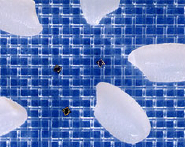By Jonathan Collins
Sept. 4, 2003 – Japanese semiconductor giant Hitachi has unveiled a prototype of its tiny RFID µ-chip, or mu-chip, which features an antenna built onto the microchip. The new tag is so small that the company believes it can be embedded in paper and used to authenticate banknotes and valuable paper documents.
Hitachi says the tiny tag, which holds a 128-bit serial number, can be used in stock and bond certificates; tickets, gift certificates and coupons; and identification documents, such as passports. The mu-chip can prevent counterfeiting because it provides a traceable number and can’t be duplicated easily.
Reports that the mu-chip will be used in Japanese yen banknotes are untrue, according to Kantaro Tanii, a Hitachi spokesman. But Hitachi does anticipate that the mu-chip will be used to prevent counterfeiting of banknotes. “We have no government or bank contracts as yet, but it’s a market we expect to grow,” Tanii says.
The prototype mu-chip is 0.4 mm x 0.4 mm, the same size as the original version, which required an antenna to be attached. The tags should be more durable because there is no antenna to break off. And Hitachi says the new mu-chip should be less expensive than the existing mu-chip, because the company has eliminated the need to attach an antenna. The new chip is expected to cost half of the 50 to 70 yen each (43 to 60 U.S. cents) the current chip costs. It will be commercially available next year.
The new design uses a process called bump metalization to create the electrical contacts of an integrated circuit on the chip rather than etching the antenna onto the chip during the CMOS process. Hitachi says that, unlike etching, bump metalization eliminates the need for any specialized equipment to manufacture the chips. “We don’t need to add any additional investment to the manufacturing process for this chip,” says Tanii.
The one drawback of putting the antenna right on the tiny chip is that it shortens the read range. The new mu-chip can be read from just 1 mm (.04 inch). Even so, Hitachi is convinced that the new mu-chip makes RFID tracking possible in extremely minute and precise applications that had been impractical until now. The company already has plans to embed the new mu-chip in entrance tickets for Expo 2005 Aichi Japan, which opens on March 25, 2005.
Another high-potential application is agricultural products, where the chips can help ensure the safety of food by providing traceability of ingredients, says Tanii. The company also believes its new tag is suited to more traditional retail and supply chain applications.
Hitachi’s first mu-chip, with the external antenna, was announced in July 2001. The company says the new tag is fully compatible with all systems that use Hitachi’s current mu-chip technology.
RFID Journal University
This special series of one-day courses developed by RFID Journal addresses all of the issues you need to understand before deploying RFID technologies. To view the curriculum, including complete course outlines, click here. Or visit RFID U.
|
San Francisco
|
October 7, 2003
|
|
|
New York City
|
October 21,2003 |
|
|
Atlanta
|
November 3, 2003
|
|
|
Chicago
|
November 17, 2003
|
|


